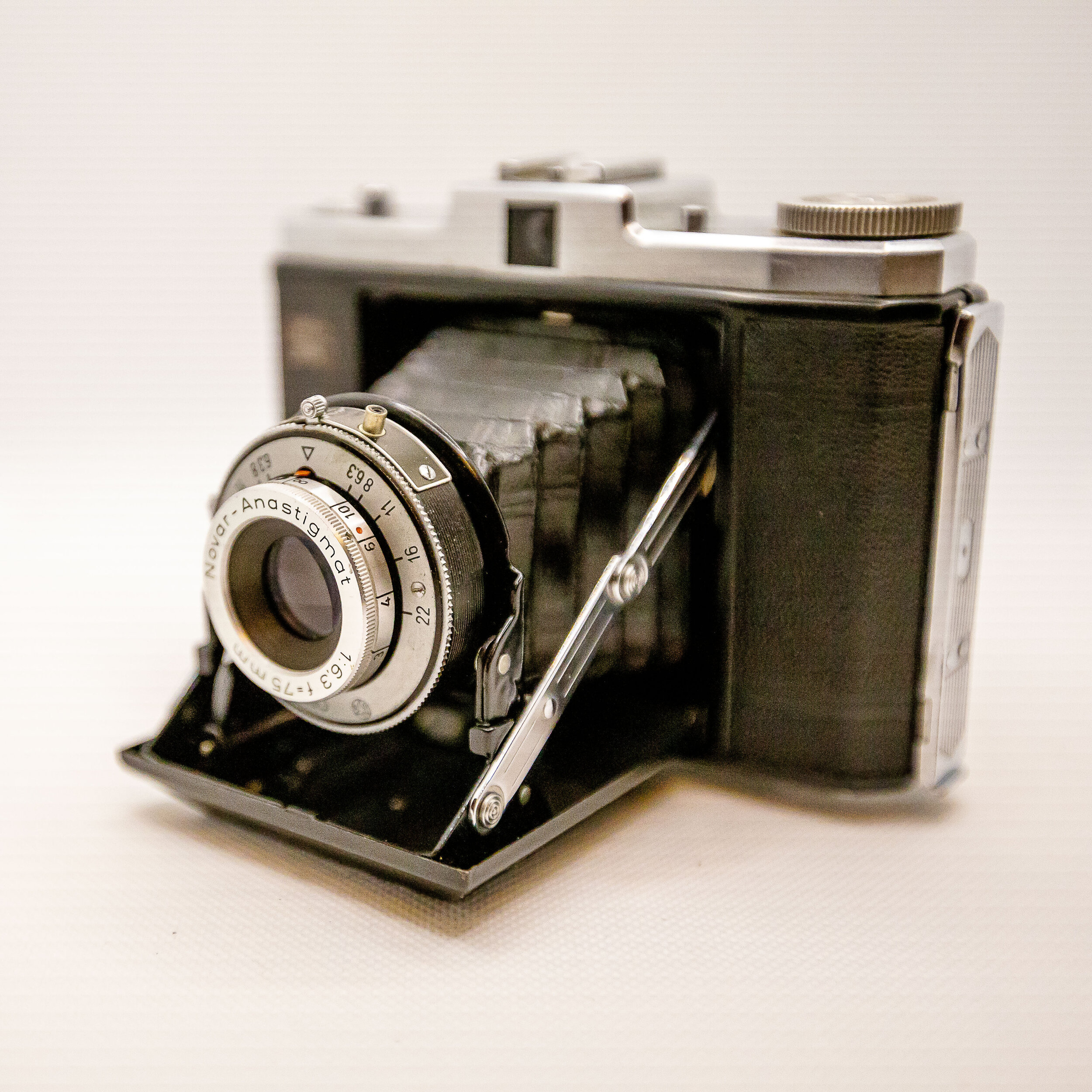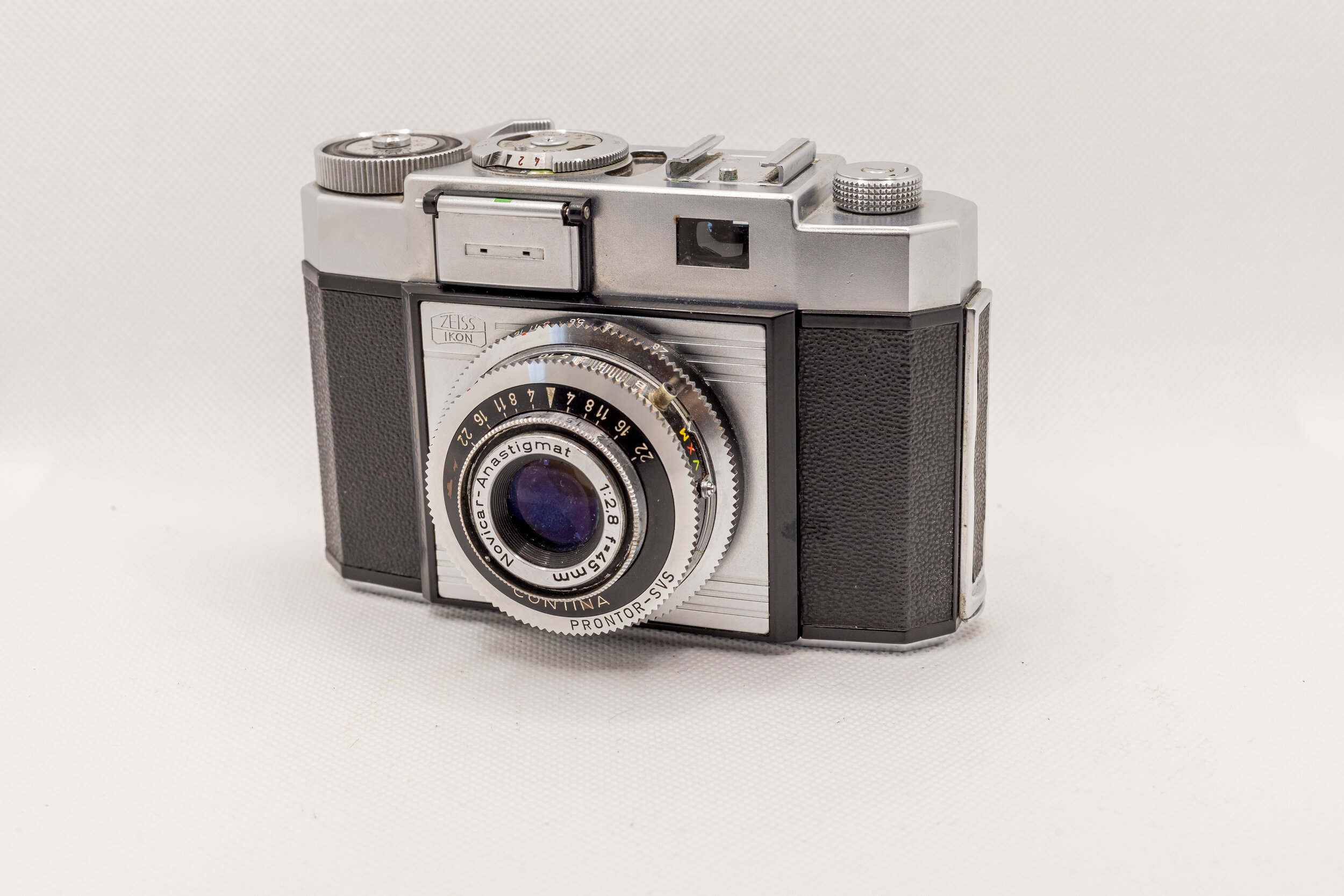My analog photography equipment Overview
I started with photography in the late 1960's in my early teens. Borrowed my father's camera a Zeiss Icon NETTA as a startup. Then in 1972 I bought my own camera, an Yashica TL Electro and started photographing friends and family. This became serious and I had always the camera with me wherever I went. Later in 1976 I upgraded to a new system camera, a Pentax ME and a 200 mm telephoto lens, and this became the start of my interest in nature photography. My girlfriend (now wife) bought a Pentax MX at the same time and we still keep them as good memories.
Kodak no.2-c autographic JR.
produced between 1916-27. It dose work and now converted for 120 fim
No.2-C Autographic Kodak Jr.
is a large format film folding bed camera made by Eastman Kodak Co., Rochester, N.Y., USA and produced between 1916-27.
It uses Kodak No. A 130 Autographic roll film cartridge for 7x12cm (2 7/8 x 4 7/8 inches) frames. The No.2C body was constructed of aluminum and covered in fine seal grain leather. The metal parts were finished in nickel or black enamel. Features included a folding black bellows design, adjustable focus with automatic focusing lock, reversible finder and two tripod sockets. Fitted with a Rapid Rectilinear lens with a Kodak ball bearing shutter.
I have now converted this camera to fit the 120 film as the A 130 Autographic roll film do not exist anymore.
Kodak No. 2 Folding Brownie
produced between 1915 and 1926, dose not work that good anymore
No 2 Folding Autographic Brownie
Conventional vertical format folding camera where the lens standard is pulled out on a track fixed to the baseboard. Imitation leather covering over a metal body. Autographic back with stylus held in clip adjacent to autographic window. Brilliant finder at top centre of the lens standard. Focusing scale on baseboard, which is notched at preset distances to engage with a catch on side of the lens standard.
Early versions were produced in a rectangular, square ended format. This changed quite early on to the more usual body shape with rounded ends.
120 rollfilm (autographic) for pictures 2¼" x 3¼"
Agfa Billy Record
produced between 1933-49, dose work but problem with the focus on the lens
Agfa Billy Record
AGFA Billy Record is a series of medium format film folding camera made by AGFA and produced between 1933-49.
Billy record cameras were listed in catalogs by lens openings as models 8.8, 7.7, 6.3 and 4.5. The names are based on the maximum lens opening. The basic body is the same for 8.8, 7.7 and 6.3 models. The 4.5 model uses the body style of the AGFA Billy Compure. All models use 120 roll film for 6x9cm frames.
The lens is AGFA Anastigmat Igestar in Automat shutter in 8.8, 7.7 and 6.3 models. There are some cosmetic variations, like chrome decors, during their production period.
Zeiss ikon nettar
does work, but not that good anymore
Zeiss ikon nettar
The Nettar series by Zeiss Ikon was a successful range of self-erecting folding cameras for 120 roll film (often described as B2 6x9 film). Several types were offered for 6×9cm, 6×6cm and 6×4.5cm format, with different lenses in a variety of shutters. Zeiss Ikon also produced a Nettar equipped with an exposure meter, the Nettax (513/16).
Zeiss Ikon always advertised the Nettar series as being for the amateur photographer. Nevertheless these cameras share many parts with the much more expensive Ikonta series (e.g. body and struts). The Nettar series may lack the higher specified lens/shutter combinations and things like film type and speed memo discs but the observed built quality is en par with that of the Ikontas.
Pentax MX
Still in use, but not that good anymore
Pentax MX
The Pentax MX was a 35 mm single-lens reflex camera produced by Asahi Optical Co, later Pentax of Japan between 1976 and 1985.
It was Pentax's flagship professional SLR until the introduction of the Pentax LX. Internally, the MX is essentially a smaller, lighter version of the Pentax KX, and otherwise has little in common with the rest of the Pentax M-series.
However, the MX was designed as the mechanical twin sister of the remarkably successful entry-level Pentax ME.
Pentax ME
The Pentax ME was a 1976-introduced, aperture priority automatic camera with an electronic focal plane shutter from 8 s to 1/1000 s, synchronized at 1/100 s. The shutter curtains were metal and had a vertical movement. There was no shutter dial, and the camera could not be used in manual mode, except for B and 1/100 exposures. The Pentax-invented digital light meter was of the standard TTL open aperture center weighted type. It was activated by a slight pressure on the release button.
The Pentax ME could attach an external winder ME I (1.5 i/s) or the later ME II (2i/s). The Pentax ME could also mount a Dial Data ME databack, or the later Digital Data M databack via a cord adapter.
Rolleiflex 3,5 T typ2
My 6x6 Street photo Camera and works fine
Rolleiflex T model 2 Black leather Synchro-Compur VXM
Tessar f 3,5 / 75 mm, Synchro-Compur VXMm
Serial number: T 2.161.237
Produce 1961-1964. The camera has a 75mm Tessar lens made of lanthanum glass, giving higher resolution and color correction.
Taking Lens: Tessar 3,5 / 75mm, Zeiss Oberkochen Bayonet 1.
Finder lens: Zeiss Heidosmat 2,8 / 75mm, Bayonet 1
Shutter: Synchro Compur MXV, 1 - 1/500 sec., B, X-sync., self timer.
Film: 120 for 12 exp. 6x6, also 16 exp. 4.5x6 or 4x4 and 35mm adapter Rolleikin 2. Special order: taking 220 film for 12 or 24 exposures. With exposure metering
Dimensions: 11.2x9.7x17.8cm. Weight: 1,020 grams.
Voigtländer Vito B
The Vito B is an attractive and compact 35mm viewfinder introduced in 1954 by Voigtländer, and produced until 1959. The Vito B body existed in two versions. The first (1954 to 1957) had a small viewfinder and low profile top plate. The later version (1957 to 1959) had a larger bright-frame viewfinder.
Both versions were fitted with the fine Color-Skopar 50mm fixed lens, with either an f/3.5 or f/2.8 maximum aperture (a four element Tessar-type) in a 4-speed Pronto or 9-speed Prontor shutter.
The Vito B's body is compact and rounded, a look characterised as "cute".[3] It has some nice features including a hinged baseplate for easy loading (which also releases the back), a milled film counter that counts down rather than up, and a switch-operated pop-up rewind knob.
While the later models had a brighter (and more useful than the original Vito B's) viewfinder, some enthusiasts feel that this spoiled the appearance of the camera.[4]
The counter to this assessment based on aesthetics is that the larger viewfinder made the camera easier to use.
HASSELBLAD 500 SERIES
My 6x6 Landscape and portrait Camera
Hasselblad 500 c/m with CF Planar f 2,8 /80 mm
Hasselblad 500 c/m black with the CF lens Planar f 2,8 / 800 mm from Carl Zeiss. Here with Film back A12 black.
Serial number: RT 1313131 Camera
Serial number: RU 3317511 Film back
The Hasselblad 500 C/M is a medium format film camera using 120 or 220 film. It will give you a dozen 6×6 negatives per roll (24 on a 220 roll).
The kit I bought 2021 is from 1986, though the camera was produced up until 1994. It included the camera body, an 80mm f/2.8 Planar Zeiss lens, A12 film back and waist level viewfinder.
The 500 C/M is a modified version of the earlier Hasselblad 500 C, and includes a focus screen that is easily removed and replaced.
Voigtländer Bessa L
All the Cosina Voigtländer Bessa models have a vertically-traveling metal focal plane shutter ranging from 1 to 1/2000s and bulb (B), with flash sync at 1/125s via hot-shoe or PC terminal. They all have TTL exposure metering, and manual exposure.
The Bessa range was derived from a camera platform developed by Cosina for inexpensive SLR bodies sold under numerous brands. Rangefinder lenses can focus bright light (including the sun) directly on the shutter blades (this would be blocked by a reflex mirror) and so the Bessas use a modified Copal shutter with a second, inner set of metal blades to ensure light-tightness. These are finished in gray and are the surface from which light meter readings are taken.
The first model was the Bessa-L, introduced in 1999. This is a finderless body with a Leica screw mount. It was introduced with 15mm and 25mm Voigtländer 39mm screw lenses, both quite inexpensive and said to be of excellent quality. It can of course mount a wide variety of 39mm screw lenses by manufacturers as diverse as Leitz, Canon, and Nikon and even cheap but often excellent Soviet lenses.
Canon EOS-1V HS
My best analog 35 mm camera
Canon EOS-1v HS with a vertical batteries grip with contols
The Canon EOS-1V is Canon's top-of-the line 35mm SLR; their best EOS autofocus 35mm SLR ever. The EOS-1V contains everything Canon knows about making a top-notch professional camera.
The EOS 1V was the camera that captured most sports and news photos seen in magazines from its introduction in 2000 until Canon's DSLRs had enough quality to replace film around 2005. Newspapers had gone to DSLRs in about 1999, but for color weekly and monthly sports magazines, 35mm film shot in the 1V ruled until about 2005.
1V HS is the father of all 1D series bodies, it’s build like a tank thanks to its magnesium alloy body and has a degree of weather sealing on it. The HS version I got also has a vertical grip with controls that takes 8 AA batteries to power the camera. The size with the grip is similar to the modern 1D and the ergonomics feel alike also.
Carl Zeiss Ikon Contina 50mm f2,8
During WWII Hubert Nerwin of Zeiss Ikon began planning for a new 35mm folder. His concepts were developed after the war to become Zeiss's first completely new postwar product. This series soon carried the name Contina
The first model introduced in 1948 had the Zeiss-Ikon designation Ikonta 35 522/24. A folder camera, with a 4.5cm (45mm) lens and short bellows; double exposure prevention has introduced by cocking the shutter with the film sprockets.
The model was continued in 1953 as Contina, as one of the first cameras of the new Contina series of 35mm viewfinder cameras (one was a rangefinder). After the initial series of folders, later models were rigid-bodied. Some had linked shutter/aperture rings, using the Light-value system.
The folding models had knob wind, frame counter and rewind fitted to the bottom; the later ones had top-mounted 180° lever wind, knob rewind and frame counter around the shutter release.
Information from following source; Camerapedia Wiki, Camera-wiki.org and Wikipedia and The International Rolleiclub , the number one source for all Rollei and Rolleiflex camera data since 1999











